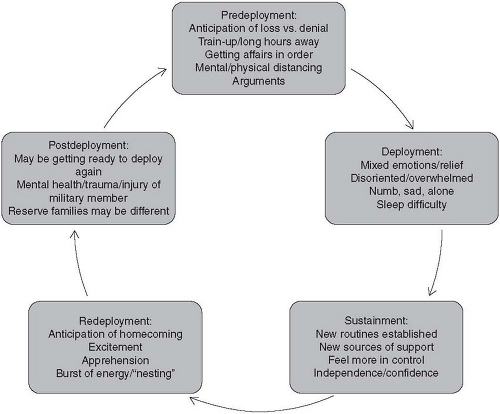Military Families and Deployment
Molinda Chartrand
I. Description.
A. Military deployment. Deployment is the short-term assignment of military service members to a duty location other than the one to which they are assigned. Deployments may be planned or unexpected, to a combat or noncombat zone, and can last from 1 to 18 months. The current average length of deployment across all military services is 12 months. One thing that all deployments have in common is the separation of service members from their family. Both active duty and reserve military members experience deployment. These deployments may have significant repercussions for every member of the military family.
B. Military culture. The military, in the broadest sense, encompasses everyone that wears a military uniform as well as his or her family members. This includes both active duty (fulltime) military service members and the reserve/guard component members. In general, the military community tends to be close-knit and supportive. On top of shared day-to-day and life experiences, there are strong core values for each service (Army, Air Force, Navy, and Marines) that help to bring a sense of purpose and meaning through difficult times. Among those are patriotism, duty, honor, and courage.
Military families routinely face many stressors such as frequent moves, separation from extended family support systems, and significant job-related hazards. They are typically resilient to these various challenges. The factors that contribute to military family resilience are not different from those for civilian families; that is, the health, mental health, and functioning of the mother, the father, and the family contribute to the development and well-being of children.
II. Demographics.
A. Active duty members. In 2009, there were 1.4 million active duty military members in the Army, Air Force, Navy, and Marines. They are accompanied by 700,000 spouses and more than 1.2 million children (0-5 years: 40%; 6-11 years: 32%). They typically live on or near a military base, have relatively easy access to a wide variety of military support services including family-readiness center, military family life consultants, mental health care providers, spousal support groups, and child care.
B. Reserve members. In 2009, the reserve component had more than 1.1 million members, 455,000 spouses, and 720,000 children (0-5 years: 24%; 6-14 years: 47%). Service members and their families who are serving in the reserves face unique challenges. These “citizen soldiers” are rarely located near a large military base and as a result have limited access to military-specific resources that are related to deployment. These service members and their families often receive their medical care in the civilian community from clinicians who may not be as aware of military unique circumstances or the impact of deployments on families.
III. Deployment.
A. Emotional cycle of deployment. Every family handles deployments differently. For some families, deployment is a part of the “military lifestyle”; they are resilient and able to cope with minor hiccups. For other families, deployment can be a catastrophe. A family’s response to deployment can be complicated and is not limited just to the time of separation. The emotional cycle of deployment (Fig. 101-1) is a typical and predictable pattern of emotional response when a military member is deployed. The cycle can provide a guide for intervention. The framework divides deployment into five phases: predeployment, deployment, sustainment, redeployment, and postdeployment. Each stage is characterized by a defined set of emotional changes and different stressors.
During predeployment, the family has been notified that the family member is leaving. Family members may not know where, and it may also be short notice. Accompanied by this notification is an immediate anticipation of loss that is balanced by denial. Military service members often spend long hours away from the family training and getting
affairs in order. There can be a mental/physical distancing. Emotional stress may lead to arguments and saying things you wish you had not on the part of everyone.

Figure 101-1. The Emotional Cycle of Deployment. Adapted from Logan KL. “Emotional Cycle of Deployment,” Logan KV. The Emotional Cycle of Deployment. Proceedings, Feb 1987:43-47.
With deployment, there can be mixed emotions, even a sense of relief. The remaining parent can feel overwhelmed with new duties. There may be difficulty with sleep.
After some time, the family members enters the sustainment phase. They settle into new routines, and new sources of support are found (may be more difficult for reserve families). There also may be a sense of independence and confidence.
With redeployment home of the service member, the anticipation of homecoming is a new emotional whirlwind: excitement, apprehension.
Finally, the member has returned home in the postdeployment phase: there is the joy of having him or her home safe and sound, but there is a loss of independence, disruption of routines, and the challenge of reintegrating the military member back into the family. Because of the recent trend toward back-to-back deployments, some have begun to speak of deployment as a “spiral” rather than a “cycle” because there is never a return to normal life.
B. Risk factors during deployment. Research conducted during the first Gulf War and the current conflicts has identified certain characteristics that can place a family at greater risk for adverse response to deployment. They are as follows:
Stay updated, free articles. Join our Telegram channel

Full access? Get Clinical Tree


